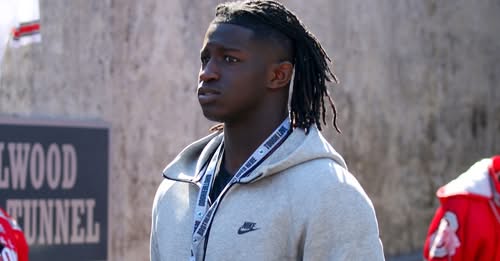Ohio State University has long been a powerhouse in college football recruiting, especially when it comes to securing top-tier defensive talent. The Buckeyes’ reputation for developing elite defensive ends is well-established, and their ability to attract some of the nation’s most promising players has been a key factor in their sustained success. However, in the ever-competitive world of college football recruiting, no program is immune to setbacks. Recently, Ohio State experienced a significant disappointment as Landon Barnes, one of the top defensive end prospects in the country, committed to Ole Miss, leaving the Buckeyes once again missing out on a coveted target.
Landon Barnes’ commitment to Ole Miss represents a notable recruiting victory for the Rebels and a loss for Ohio State. Barnes, a highly regarded defensive end, had been on the Buckeyes’ radar for some time. His skill set, athleticism, and potential fit within Ohio State’s defensive scheme made him an ideal candidate for the program. As a player who excels in both pass rushing and run defense, Barnes could have bolstered Ohio State’s defensive front and added depth and versatility to their lineup. Yet, despite the interest from the Buckeyes, Barnes ultimately decided to join Ole Miss, leaving questions about what led to the decision and what this means for Ohio State moving forward.
The recruiting process for top defensive ends like Barnes is intense and highly competitive. Programs across the country vie aggressively for elite talent, knowing that a single commitment can have ripple effects on a team’s defensive success. For Ohio State, consistently landing top defensive ends has been crucial. Players like Chase Young, Nick Bosa, and Joey Bosa have become household names, contributing to Ohio State’s defensive dominance in recent years and going on to successful NFL careers. The standard is high, and the pressure to maintain this level of recruitment is immense.
Barnes’ recruitment was no exception to this pattern of fierce competition. Several factors can influence a prospect’s decision, including coaching relationships, playing time opportunities, defensive schemes, campus culture, and the chance to compete for championships. In Barnes’ case, Ole Miss evidently made a compelling pitch that resonated with him. The Rebels have been steadily improving their program under head coach Lane Kiffin, who has built a reputation for developing defensive talent and creating a dynamic, fast-paced team environment.
Ole Miss’ recruiting strategy has increasingly focused on attracting high-profile players who may have been overlooked by traditionally dominant programs or who see the Rebels as a place where they can make an immediate impact. For Barnes, this approach likely offered a blend of opportunity and excitement. Being a key contributor early in his college career at Ole Miss might have been more appealing than competing for playing time at Ohio State, where the depth chart is often stacked with elite athletes.
Another significant factor in recruiting battles is the relationship between the player and the coaching staff. The bond that develops during the recruitment process can heavily influence a player’s decision. Ole Miss’ coaching staff might have connected better with Barnes on a personal level or made him feel more valued as a future cornerstone of their defense. Meanwhile, Ohio State’s recruiting approach, while historically effective, might not have struck the same chord this time around. With the recruiting landscape becoming increasingly personal and nuanced, these intangible elements can tip the scales in a player’s commitment.
Additionally, the defensive scheme and style of play can be pivotal. Barnes, as a defensive end, would want to ensure that his skills are showcased and developed to their fullest potential. If Ole Miss’ defensive system aligns more closely with his strengths or offers a role that suits his style, that could have been a decisive factor. Ohio State’s defensive schemes have evolved over time, and while they have been successful, they may not always fit every player’s individual preferences or long-term goals.
For Ohio State, missing out on Barnes is certainly a setback but not an insurmountable one. The program’s recruiting class remains strong, and the Buckeyes have a track record of finding and developing defensive end talent. However, the loss highlights the challenges even elite programs face in today’s hyper-competitive recruiting environment. The recruiting landscape is no longer dominated by a handful of traditional powers; emerging programs like Ole Miss are closing the gap and attracting top prospects by offering compelling opportunities and personalized recruitment experiences.
The implications for Ohio State extend beyond just this single commitment. Defensive ends play a crucial role in shaping the identity of the team’s defense, especially in a conference as physically demanding as the Big Ten. The Buckeyes rely on relentless pass rushers to pressure opposing quarterbacks and disrupt offensive schemes. Losing a player like Barnes means the coaching staff must adapt and potentially look deeper into their recruiting pool to fill the void.
Moreover, this loss might influence Ohio State’s strategy moving forward. The program may need to reinforce its recruiting efforts in the defensive end position, perhaps by expanding their reach geographically or intensifying the personal engagement with prospects. The competition is fierce, and staying at the forefront requires constant innovation in recruiting tactics and player development promises.
On the other hand, Ole Miss securing Landon Barnes is a clear sign of the program’s rising stature and recruiting prowess. It sends a message to future prospects that Ole Miss is a destination for top defensive talent and that the Rebels are serious contenders in the recruiting wars. For a program looking to cement its place among college football’s elite, attracting players like Barnes is vital. It not only strengthens the immediate roster but also builds momentum for future recruiting classes.
This development also underscores the evolving dynamics in college football, where the traditional recruiting powerhouses no longer hold an uncontested grip on the best players. Factors such as coaching staff turnover, changing defensive philosophies, and the rise of new contenders mean that prospects have more choices and leverage than ever before. Programs like Ole Miss are capitalizing on this shift, leveraging their unique selling points and offering alternatives to the blue-blood programs.
In the context of Ohio State, this loss could serve as a valuable lesson. It highlights the importance of not just chasing the best talent but also cultivating relationships and aligning player aspirations with program goals. Recruiting is as much about culture fit and vision as it is about on-field talent. The Buckeyes must continue to refine their approach, emphasizing what makes their program distinct, and ensuring that prospects see Ohio State as the best place to achieve their personal and athletic dreams.
For fans and followers of Ohio State football, this news might be disappointing but not devastating. The program’s strong foundation and recruiting network remain intact. There will be more opportunities to secure top defensive end prospects in the future. The coaching staff will undoubtedly be working hard behind the scenes to identify new talent and keep Ohio State competitive at the highest level.
Meanwhile, Landon Barnes’ journey at Ole Miss will be watched closely. His development and performance will not only impact the Rebels but also serve as a benchmark for other prospects considering Ole Miss over traditional powers. Success stories like Barnes’ can help programs build credibility and sustain recruiting momentum, creating a positive cycle of growth and achievement.
In conclusion, Ohio State missing out on Landon Barnes is a reminder that recruiting is a complex, competitive, and sometimes unpredictable process. Even the most storied programs face challenges in securing every target, especially in today’s shifting college football landscape. While this loss stings, it also presents an opportunity for Ohio State to evaluate, adapt, and strengthen its recruiting strategies. Meanwhile, Ole Miss gains a significant boost in landing a top defensive end prospect, signaling their intent to compete at the highest level. The recruiting season continues, and with it, the drama and excitement that come with chasing the next generation of college football stars.



